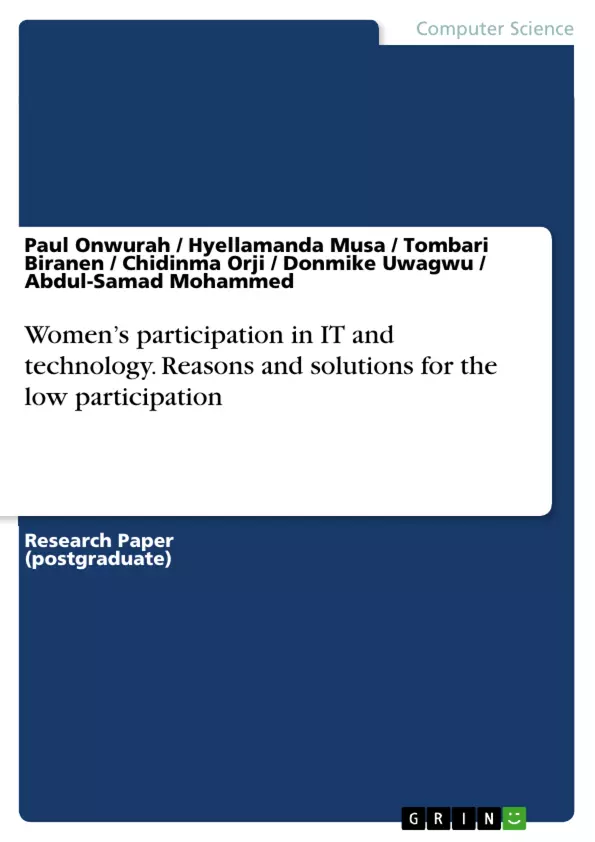The world is changing and will still change more, only at an ever-increasing pace. The events and innovations of the last few centuries have served as testaments to the validity of this fact. The influence that science, technology and more recently, ICT have had on the world’s dynamics cannot be overrated or over emphasized. ICT for example has become one of the strongest forces of the modern world, with applications in virtually every facet of human existence, from medicine to communications; transportation to entertainment; defense to artificial intelligence.
Unfortunately, statistics have shown that women’s participation in IT and technology in general is low and declining. Berryman (1983) used the ‘leaky pipeline’ metaphor to describe the attrition of women from science and technology in general. The leaky pipeline is used to describe the “continuous loss of women in science and technology as they climb the career ladder” (Muffit, 2014). It has also been noted that employment opportunities for women in technological and engineering fields have been very low especially in areas such as the computer industry (Hoffmann-Barthes, Nair, & Malpede).
This paper seeks primarily to evaluate the low participation of women in technology and ICT, and to identify the obstacles hindering higher participation, in a bid to proffering solutions that will eliminate or at least reduce the effect of the obstacles.
Inhaltsverzeichnis (Table of Contents)
- Introduction
- Women's Participation in IT: a Global Perspective
- Reasons for low participation of women in ICT and Technology
- Education-based Barriers to Participation
- Cultural Barriers
- Attitudinal Barriers
- Qualificatory Barriers
- Situational Barriers
- Institutional Barriers
- Employment-related Barriers
- Education-based Barriers to Participation
- The Way Forward
- Gender Equality
Zielsetzung und Themenschwerpunkte (Objectives and Key Themes)
This paper explores the reasons behind women's low participation in Information and Communication Technology (ICT) and technology fields, aiming to identify obstacles hindering their involvement and propose solutions to address them.- Global Perspective on Women's Participation in IT
- Barriers to Women's Participation in ICT: Educational and Employment-Related Factors
- Cultural Influence on Women's ICT Participation
- The Importance of Gender Equality in Fostering Women's ICT Involvement
- Proposed Solutions to Increase Women's Participation in ICT
Zusammenfassung der Kapitel (Chapter Summaries)
The introduction highlights the rapid advancements in science, technology, and ICT, emphasizing their profound impact on various aspects of human life. Despite this, women's participation in IT remains low and declining. The paper uses the "leaky pipeline" metaphor to describe the attrition of women from science and technology fields. The paper then examines the global perspective on women's participation in IT, noting the low and declining enrollment of women in IT education and employment worldwide. While some progress has been made in other fields, the percentage of women in ICT has remained stagnant. The paper delves into the reasons behind this low participation, categorizing the barriers into three groups: education-related, employment-related, and cultural. Educational barriers include cultural norms that perpetuate gender stereotypes, attitudinal biases regarding women's capabilities, and the lack of female role models in the field. The paper then explores employment-related barriers, including the gender pay gap and societal expectations that often limit women's career opportunities in technology. The conclusion argues that addressing gender inequality is crucial to improving women's participation in ICT.Schlüsselwörter (Keywords)
The paper focuses on the underrepresentation of women in technology and ICT fields. Key terms include gender equality, gender pay gap, cultural barriers, attitudinal barriers, educational barriers, employment barriers, and ICT participation. The paper seeks to understand the complex interplay of these factors and propose solutions to improve women's participation in ICT.- Quote paper
- Paul Onwurah (Author), Hyellamanda Musa (Author), Tombari Biranen (Author), Chidinma Orji (Author), Donmike Uwagwu (Author), Abdul-Samad Mohammed (Author), 2014, Women’s participation in IT and technology. Reasons and solutions for the low participation, Munich, GRIN Verlag, https://www.hausarbeiten.de/document/271673


